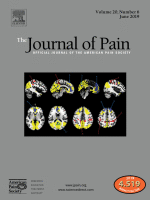Decreasing Pain Ratings in Chronic Arm Pain Through Changing a Virtual Body: Different Strategies for Different Pain Types
Abstract
Modifying the visual aspect of a virtual arm that is felt as one’s own using immersive virtual reality (VR) modifies pain threshold in healthy subjects, but does it modify pain ratings in chronic pain patients? Our aim was to investigate whether varying properties of a virtual arm co-located with the real arm modulated pain ratings in patients with chronic arm/hand pain because of complex regional pain syndrome (CRPS) type I (without nerve injury) or peripheral nerve injury (PNI). CRPS (n = 9) and PNI (n = 10) patients were immersed in VR and the virtual arm was shown at 4 transparency levels (transparency test) and 3 sizes (size test). We evaluated pain ratings throughout the conditions and assessed the virtual experience, finding that patients with chronic pain can achieve levels of ownership and agency over a virtual arm similar to healthy participants. All 7 conditions globally decreased pain ratings by half. Increasing transparency decreased pain in CRPS but did the opposite in PNI, whereas increasing size slightly increased pain ratings only in CRPS. We conclude that embodiment in VR can decrease pain ratings in chronic arm pain, although the type of pain determines which strategy to decrease pain is most useful. We discuss this through the interactions between body image and pain perception.
Perspective
“Embodiment” in VR is useful to decrease pain ratings in chronic pain patients, but the best strategy needs to be tuned to the pain etiology. This approach could potentially help patients with chronic pain and clinicians who seek alternatives to pain management for patients.
Section snippets
Participants
Nineteen patients between 40 and 55 years old with neuropathic chronic pain in the upper limb were enrolled in this study. They were patients of the Pain Unit at Hospital Clínic de Barcelona. Patients with CRPS type I had been previously diagnosed based on the Budapest criteria for CRPS20 by neurologists at the hospital (Hospital Clínic de Barcelona). Patients were recruited and grouped into those with CRPS type I, without nerve injury (9 patients), and those with PNI, with nerve injury …
Results
Nineteen patients were included in the study and grouped into those without nerve injury (9 patients with CRPS type I) and those with peripheral nerve injury (10 patients with PNI). The groups did not differ at baseline in terms of age, cognitive function (MMSE and FAB scores), degree of neuropathic pain (painDETECT), and pain ratings (Table 1). However, we included MMSE and age in the model (Equation 1) because preliminary investigation showed that variation in these may influence the results.
Discussion
Congruent multisensory correlations between the real and a virtual arm in immersive VR has been shown to induce an illusion of ownership over the virtual arm.51, 53 The appearance of such a virtual arm modulates the pain threshold in healthy controls,34, 35, 36,42 but can we extrapolate the observations regarding pain threshold in healthy subjects to chronic pain patients? To answer this, we investigated whether varying the transparency and size of a virtual arm that is co-located with the real…
Acknowledgments
Partially funded by AGAUR (2017-SGR1296) and by CERCA Programme/Generalitat de Catalunya. We thank Ramón Oliva from the Event-Lab for the virtual reality scenarios, and for technical support; Cristina Gonzalez-Liencres and Tony Donegan for editing assistance; the medical staff of the pain management clinic section of Hospital Clínic de Barcelona, headed by Carme Busquets Julià, for facilitating patients to conduct the study; and Isabel Sañudo, head of the department of rehabilitation of…
References (62)
-
U Baas et al. Personal neglect: A disorder of body representation? Neuropsychologia (2011)
-
JT Farrar et al. Clinical importance of changes in chronic pain intensity measured on an 11-point numerical pain rating scale Pain (2001)
-
E Furman et al. Virtual reality distraction for pain control during periodontal scaling and root planing procedures J Am Dent Assoc (2009)
-
B Galer et al. Neglect-like symptoms in complex regional pain syndrome: Results of a self-administered survey J Pain Symptom Manage (1999)
-
J Gierthmühlen et al. Sensory signs in complex regional pain syndrome and peripheral nerve injury Pain (2012)
-
MJ Giummarra et al. Central mechanisms in phantom limb perception: The past, present and future Brain Res Rev (2007)
-
P Haggard et al. Sense of agency Curr Biol (2012)
-
A Hänsel et al. Seeing and identifying with a virtual body decreases pain perception Eur J Pain (2011)
-
RN Harden et al. Validation of proposed diagnostic criteria (the “Budapest Criteria”) for complex regional pain syndrome Pain (2010)
-
H Hoffman et al. Virtual reality as an adjunctive pain control during burn wound care in adolescent patients Pain (2000)
Cited by (70)
-
The sensorimotor theory of pathological pain revisited
2022, Neuroscience and Biobehavioral ReviewsCitation Excerpt :However, the type of illusions that are effective for pain relief can vary both between and within conditions. For instance, magnification of a limb reduced pain for people with peripheral nerve injury, but increased pain for people with CRPS (Matamala-Gomez et al., 2019b). People with knee osteoarthritis (Stanton et al., 2018) or CRPS (Lewis et al., 2021) required different illusions (e.g. stretching versus shrinking) to attain pain relief, despite the fact that participants generally perceived their affected limbs to be larger than in reality (see 2.3.1).
-
Virtual Reality in Clinical Psychology
2022, Comprehensive Clinical Psychology, Second Edition -
Virtual embodiment in fibromyalgia
2023, Scientific Reports
Recommended articles (6)
-
Research article Pain-Induced Reduction in Corticomotor Excitability Is Counteracted by Combined Action-Observation and Motor Imagery
The Journal of Pain, Volume 20, Issue 11, 2019, pp. 1307-1316 -
Research article Feasibility and Safety of a Virtual Reality Dodgeball Intervention for Chronic Low Back Pain: A Randomized Clinical Trial
The Journal of Pain, Volume 17, Issue 12, 2016, pp. 1302-1317 -
Research article Violating body movement semantics: Neural signatures of self-generated and external-generated errors
NeuroImage, Volume 124, Part A, 2016, pp. 147-156 -
Research article Social Influences on Peer Judgments about Chronic Pain and Disability
The Journal of Pain, Volume 20, Issue 6, 2019, pp. 698-705 -
Research article Seeing an Embodied Virtual Hand is Analgesic Contingent on Colocation
The Journal of Pain, Volume 18, Issue 6, 2017, pp. 645-655 -
Research article Influence of cognitive stance and physical perspective on subjective and autonomic reactivity to observed pain and pleasure: An immersive virtual reality study
Consciousness and Cognition, Volume 67, 2019, pp. 86-97Observing others’ pain may induce a reaction called personal distress that may be influenced by top-down (imagine self or other in pain, i.e., self- vs other-oriented stance) and bottom-up (physical perspective of those who suffer, i.e., first vs third person perspective- 1PP vs 3PP) processes. The different contributions of these processes have not been teased apart. By capitalizing on the power of Immersive Virtual Reality, we explored how behavioural (subjective ratings) and physiological reactivity (skin conductance reactivity, SCR) to pain and pleasure delivered to an avatar was influenced by Cognitive stance and Physical perspective. Taking an Other-Oriented stance leads to attributing higher congruent valence (i.e. pain rated as unpleasant and pleasure as pleasant) and intensity to the stimuli and induces reduced SCR. Ownership over the virtual limb was maximal in 1PP where physiological reactivity to the stimuli was comparable. Our results highlight different components underpinning reactivity to pain and pleasure.


